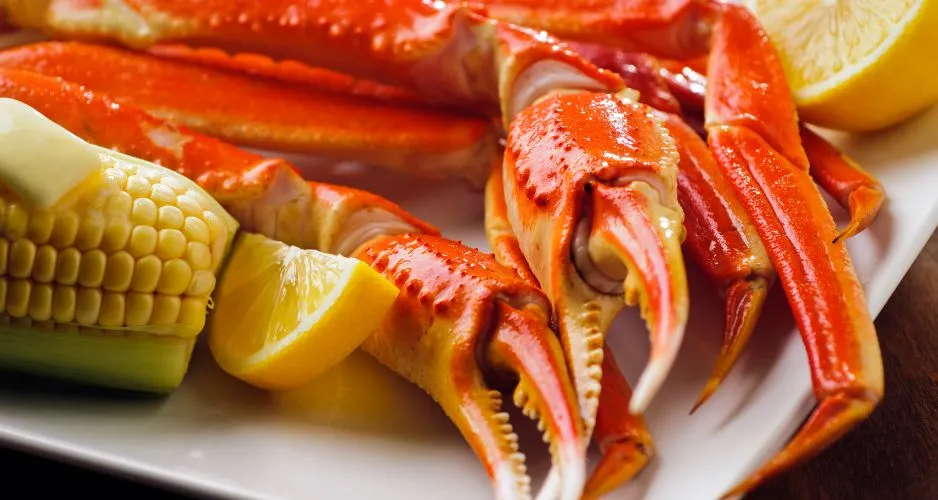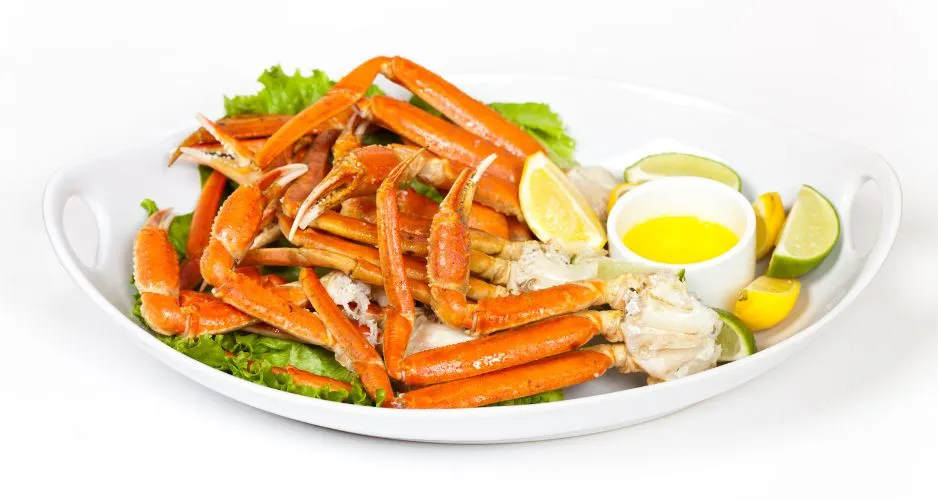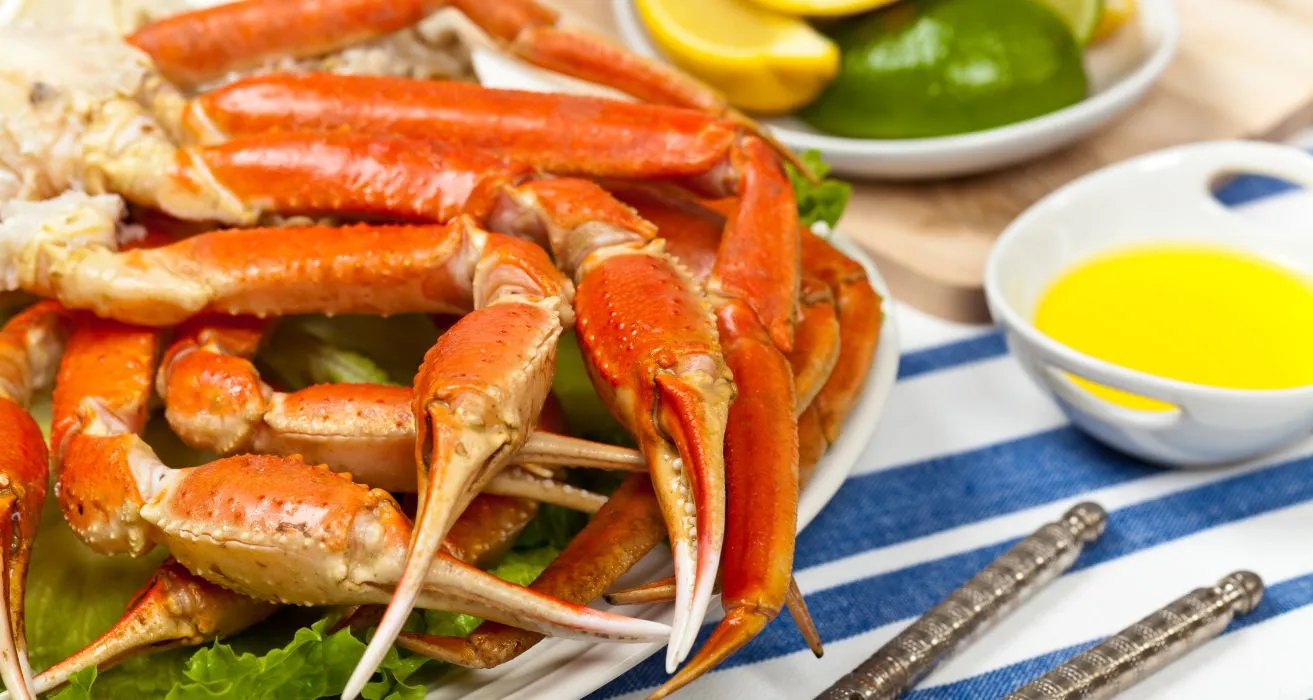Cracking open the world of crab legs unveils a treasure trove of flavors, textures, and culinary delights that can transform any meal into a celebratory feast. Whether it’s the king of the catch, the King Crab, or its more accessible cousin, the Snow Crab, these shellfish delicacies offer a unique taste of the ocean’s bounty. This article dives deep into everything crab legs—from selecting the freshest catch to mastering the art of cooking them to perfection. Along the way, we’ll explore the nutritional benefits of yummy seafood, answer some frequently asked questions, and provide some pro tips to elevate your seafood dining experience. So, let’s get cracking!
Introduction
Crab legs, a delicacy revered across the globe, offer more than just a tantalizing taste of the sea. They embody a rich cultural heritage and a history as deep and vast as the oceans they come from. In this section, we embark on a journey to explore the essence of this seafood, delving into their cultural significance and the culinary journey they’ve embarked on over centuries.
With their sweet, succulent meat, they have graced tables in various forms, from simple, rustic preparations to elaborate gourmet dishes. Their journey from ocean to table is a testament to human ingenuity in seafood harvesting and cuisine. As we peel back the layers, we discover not just a seafood item, but a cultural icon that has stood the test of time.
So, let’s set sail on this culinary voyage, exploring the depths of flavor, nutrition, and culinary delight that they have to offer. With every crack and twist, we uncover the secrets to selecting, preparing, and savoring this exquisite seafood, ensuring that your dining experience is nothing short of spectacular.
Types of Crab Legs
Crab legs come in a variety of types, each with its unique flavor profile, texture, and size. In this exploration, we’ll dive into the world of the most popular crab legs, helping you navigate the sea of options for your next seafood feast.

King Crab Legs
King Crab Legs, the titans of the crab world, are famed for their impressive size and exquisite taste. With their rich, sweet flavor and tender meat, they are a prized catch for any seafood lover. they are not just a meal; they’re an experience, offering a taste of the ocean’s majesty.
Snow Crab Legs
Snow Crab Legs, on the other hand, are known for their delicate texture and slightly sweet taste. Smaller than their King counterparts, they are nonetheless a favorite for their ease of eating and the fun of cracking open their slender legs. Perfect for a cozy seafood dinner, Snow Crab Legs bring a touch of elegance to the table.
Dungeness Crab Legs
Dungeness Crab Legs offer a balance of sweet and nutty flavors, making them a versatile option for various culinary creations. Their meat is tender and succulent, providing a delightful seafood experience that’s both satisfying and rich in taste.
Blue Crab Legs
Blue Crab Legs are smaller yet packed with flavor, offering a sweet, rich meat that’s highly sought after in culinary circles. They are perfect for those who enjoy the hands-on experience of cracking and picking their way to the delicious treasure within.
Comparison: Flavor, Texture, and Size
In comparison, each type of crab leg brings its unique characteristics to the table. King Crab Legs dominate with their size and sweet flavor, while Snow Crab Legs offer a more subtle taste and delicate texture. Dungeness and Blue Crab Legs provide a sweet and rich flavor, making them favorites among seafood enthusiasts.
In choosing the right type of crab leg for your meal, consider the flavor profile you prefer, the texture that appeals to you, and the size that suits your culinary needs. Whether it’s the majestic King Crab or the delicate Snow Crab, each brings a piece of the ocean’s bounty to your table, promising a dining experience filled with flavor, tradition, and the joy of seafood.
Nutritional Value
Crab legs are not only a luxurious treat for the palate but also a powerhouse of nutritional benefits. Let’s delve into the macronutrients and micronutrients that make them a healthy addition to your diet.
Nutritional Benefits of Crab Legs
Crab legs, low in fat and calories, are an excellent choice for those focusing on weight management or loss. Packed with protein, they’re ideal for tissue repair and building, making them popular among fitness enthusiasts and those in search of lean protein.
Rich in vitamins and minerals, they stand out as a nutritional powerhouse. With vitamin B12 for brain health and energy, zinc for immune support, and selenium, an antioxidant important for metabolism, they offer a broad spectrum of health benefits.
The omega-3 fatty acids found in them help support heart health and may reduce the risk of heart disease. These essential fats also contribute to brain and joint health, making them not just delicious but also a boon for overall wellness.
Incorporating them into your diet can enhance heart health, brain function, and immunity. Their nutrient-dense profile elevates them beyond mere delicacy status, positioning them as a smart choice for a healthy lifestyle.
Including them in your meals treats you to a flavorful experience while nourishing your body with essential nutrients. Whether enjoyed steamed, boiled, or grilled, they marry exquisite taste with substantial health benefits, delivering the best of both worlds
How to Select and Store Crab Legs
Selecting the best crab legs and knowing how to store them are crucial steps to ensuring the freshness and flavor of your seafood feast. Here, we’ll guide you through choosing the highest quality seafood and the best practices for storing them at home.
Selecting the Best Crab Legs
When choosing crab legs, freshness is crucial. Look for a bright, clean shell with no discoloration and a fresh, salty sea aroma for fresh ones. For frozen ones, ensure the package is tightly sealed without freezer burn signs.
Their size and weight also hint at quality. Heavier ones likely contain more meat, providing better value. Feel free to ask your seafood vendor for recommendations or to weigh them to ensure a top-notch selection.
Storing Crab Legs
Once selected, properly storing crab legs is crucial for maintaining their quality. Keep fresh ones in the coldest part of your refrigerator, ideally on ice, if you’ll cook them within a day or two.
For extended storage, freezing is your best bet. Wrap the legs in moisture-proof material or place them in a freezer bag, removing as much air as possible before sealing. This approach keeps them fresh for up to three months.
To thaw, plan ahead. Transfer the legs from the freezer to the fridge a day before cooking to allow for a slow, even thaw. If you’re in a hurry, submerge them in cold water, changing the water every 30 minutes until they are thoroughly thawed.
Selecting quality seafood and adhering to these storage tips ensure your seafood stays fresh. Whether for a special dinner or a casual treat, these guidelines will help ensure your crab legs are delicious.
Preparing and Cooking Crab Legs
Mastering the art of preparing and cooking crab legs is essential for unlocking their full flavor potential. Here, we’ll guide you through the steps for getting your seafood ready for the pot, as well as share various cooking techniques that will elevate your seafood dining experience.
Preparing Crab Legs for Cooking
Before cooking, if your crab legs are frozen, ensure they are fully thawed to guarantee even cooking. Rinse them under cold water to remove any ice or debris. This step helps in cleaning them and enhancing their natural flavor.

Cooking Techniques
Boiling
Boiling is a straightforward method that brings out the natural sweetness of the crab meat. Fill a large pot with enough water to cover the crab legs, add a pinch of salt, and bring it to a boil. Gently place them in the pot and cook for about 5 to 7 minutes, until heated through. This method is perfect for those who love the pure, unadulterated taste of crab.
Steaming
Steaming is another excellent method that keeps the crab legs moist and tender. Fill a pot with an inch or two of water, bring it to a boil, and then place them in a steamer insert above the water. Cover and steam for about 6 to 8 minutes. Steaming helps retain the crab’s natural flavors while ensuring the meat remains juicy.
Grilling
For a smoky flavor, grilling crab legs is a fantastic choice. Preheat your grill to a medium-high heat. Brush the legs with oil and place them on the grill. Cook for about 4 to 5 minutes on each side, until the shell is slightly charred and the meat is heated through. Grilling adds a delightful smokiness that complements the sweetness of the crab.
Baking
Baking crab legs in the oven is a simple, fuss-free method. Preheat your oven to 350°F (175°C). Place the legs in a single layer on a baking sheet, brush them with melted butter, and bake for about 15 to 20 minutes. Baking allows for a gentle cooking process that keeps them succulent.
Serving Suggestions and Pairings
Serve your perfectly cooked crab legs with a side of melted butter for dipping and lemon wedges for a refreshing citrus kick. Pair with sides like garlic mashed potatoes, steamed asparagus, or a crisp green salad to complete the meal.
With these preparation and cooking techniques, you’re well on your way to enjoying a mouthwatering crab feast that’s sure to impress. Whether you prefer the simplicity of boiling or the rich flavors achieved by grilling, each method offers a unique way to savor the exquisite taste of crab legs.
Health Benefits and Dietary Considerations
Exploring the nutritional journey of this seafood reveals its significant health benefits and essential dietary considerations. This section focuses on the advantages and factors to be mindful of when including this delicacy in your meals.
Nutritional Advantages
Renowned for their flavor, crab legs also boast an impressive nutritional profile. As a lean protein source, they support muscle repair and growth, making them a smart choice for those focusing on weight maintenance or muscle health.
They are rich in omega-3 fatty acids, beneficial for cardiovascular health by reducing inflammation and potentially lowering heart disease risk. Additionally, they are an excellent source of vitamin B12, crucial for nerve function and the production of DNA and red blood cells.
Dietary Considerations
While they make a valuable addition to various diets, it’s important to be aware of potential dietary restrictions and allergies. Shellfish allergies are particularly common, necessitating avoidance for affected individuals.
Despite being low in fat, they may contain high levels of sodium and cholesterol. Those watching their sodium intake or cholesterol levels should consume them in moderation, ensuring a balanced diet.
For those adhering to specific dietary laws, such as halal or kosher, sourcing appropriately is crucial to align with these eating practices.
FAQs
When it comes to enjoying seafood, diners often have questions about preparation, cooking, and serving. Here, we’ll address some of the most frequently asked questions to ensure your crab leg feast is a resounding success.
How long do you cook crab legs?
The cooking time depends on the method you choose. Generally, for most cooking methods:
- Boiling: 5 to 7 minutes
- Steaming: 6 to 8 minutes
- Grilling: 4 to 5 minutes per side
- Baking: 15 to 20 minutes
These times are for thawed crab legs. If cooking from frozen, add a few extra minutes to ensure they’re heated through.
Can you overcook crab legs?
Yes, it’s possible to overcook crab legs, which can result in tough and rubbery meat. To avoid this, adhere to the recommended cooking times and use a timer. Remember, they are often pre-cooked and only need to be heated through.
What are the best condiments for crab legs?
Melted butter is the classic choice, offering a rich, indulgent complement to the sweet crab meat. Lemon wedges add a refreshing zing that enhances the flavor. For those who enjoy a bit of heat, a side of cocktail sauce or a spicy aioli can add an exciting twist.
How many legs do crabs typically have?
Crabs typically have ten legs, including two larger front claws or pincers and eight smaller walking legs. The front claws are used for defense and for capturing and manipulating food, while the walking legs are used for locomotion.
What is the recommended method for cooking crab legs?
The best way to cook crab legs depends on personal preference, but popular methods include steaming, boiling, grilling, and baking. Steaming is often preferred as it heats them evenly without leaching out flavor, preserving their natural juiciness and taste.
Are crab legs safe to eat?
Yes, crab legs are safe to eat when properly cooked. It’s essential to ensure they are thoroughly heated to an internal temperature of 145°F (63°C) to kill any harmful bacteria and parasites that may be present.
Do all crabs have the same number of legs?
No, not all crabs have the same number of legs. While most true crabs have ten legs, there are variations within different species and types of crabs. Some related crustaceans may have a different number of legs.
How should beginners approach eating crab legs?
Beginners should start by using a crab cracker to break open the shell of the crab legs. Tweezers or small forks can help remove the meat from the shell. It’s a hands-on dining experience, so don’t be afraid to get a little messy and enjoy the process.
How many crab legs should be allocated per person?
The amount of crab legs per person can vary based on the type of crab and the context of the meal. For a main course, a good rule of thumb is to allocate about 1 to 2 pounds (450g to 900g) per person.
Is it preferable to eat crab legs cold or hot?
Crab legs can be enjoyed both cold and hot, depending on personal preference and the dish being prepared. Cold one are often served with dipping sauces, while hot ones are typically steamed or boiled and served with melted butter.
How many crab legs should be prepared for two adults?
For two adults, preparing about 2 to 4 pounds (900g to 1800g) of crab legs would be adequate, allowing for 1 to 2 pounds (450g to 900g) per person. This quantity can be adjusted based on appetite and whether the recipe are the main course or part of a larger meal.
What species of crab has ten legs?
True crabs, belonging to the order Decapoda, typically have ten legs. This includes popular varieties such as king crabs, snow crabs, and blue crabs. The name Decapoda itself means “ten-footed.”
Conclusion
Concluding our detailed guide, we’ve covered everything from selection and storage to cooking methods that enhance their flavor. We’ve also tackled common queries to make your seafood feast unforgettable.
This delicacy offers more than just great taste; it’s an entire experience. By applying the advice and methods from this guide, you’re set to pick, prepare, and perfectly cook them. This ensures a rewarding and tasty dining adventure.
We urge you to try different cooking methods like boiling, steaming, grilling, and baking. Each method uniquely brings out the natural sweetness.
Remember, enjoying this seafood goes beyond the dish itself. It’s about the happiness of gathering, breaking shells together, and sharing a luxurious meal. So, cheers to your upcoming celebration, filled with joy, companionship, and, of course, exquisite flavors.
Adding this delicacy to your cooking collection means not just savoring a treat. It’s about adopting a rich seafood tradition. Whether for a grand event or a casual dinner, they are sure to delight with their oceanic flavors.
